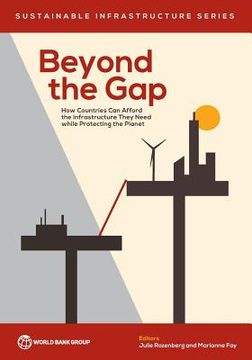Compartir
Beyond the Gap: How Countries Can Afford the Infrastructure They Need While Protecting the Planet (en Inglés)
Rozenberg, Julie ; Fay, Marianne (Autor)
·
World Bank Publications
· Tapa Blanda
Beyond the Gap: How Countries Can Afford the Infrastructure They Need While Protecting the Planet (en Inglés) - Rozenberg, Julie ; Fay, Marianne
$ 47.74
$ 66.31
Ahorras: $ 18.57
Elige la lista en la que quieres agregar tu producto o crea una nueva lista
✓ Producto agregado correctamente a la lista de deseos.
Ir a Mis Listas
Origen: Estados Unidos
(Costos de importación incluídos en el precio)
Se enviará desde nuestra bodega entre el
Viernes 12 de Julio y el
Martes 23 de Julio.
Lo recibirás en cualquier lugar de Internacional entre 1 y 3 días hábiles luego del envío.
Reseña del libro "Beyond the Gap: How Countries Can Afford the Infrastructure They Need While Protecting the Planet (en Inglés)"
Beyond the Gap: How Countries Can Afford the Infrastructure They Need while Protecting the Planet aims to shift the debate regarding investment needs away from a simple focus on spending more and toward a focus on spending better on the right objectives, using relevant metrics. It does so by offering a careful and systematic approach to estimating the funding needs to close the service gaps in water and sanitation, transportation, electricity, irrigation, and flood protection. Exploring thousands of scenarios, this report finds that funding needs depend on the service goals and policy choices of low- and middle-income countries and could range anywhere from 2 percent to 8 percent of GDP per year by 2030. Beyond the Gap also identifies a policy mix that will enable countries to achieve key international goals--universal access to water, sanitation, and electricity; greater mobility; improved food security; better protection from floods; and eventual full decarbonization--while limiting spending on new infrastructure to 4.5 percent of GDP per year. Importantly, the exploration of thousands of scenarios shows that infrastructure investment paths compatible with full decarbonization in the second half of the century need not cost more than more-polluting alternatives. Investment needs remain at 2 percent to 8 percent of GDP even when only the decarbonized scenarios are examined. The actual amount depends on the quality and quantity of services targeted, the timing of investments, construction costs, and complementary policies. Finally, investing in infrastructure is not enough; maintaining it also matters. Improving services requires much more than capital expenditure. Ensuring a steady flow of resources for operations and maintenance is a necessary condition for success. Good maintenance also generates substantial savings by reducing the total life-cycle cost of transport and water and sanitation infrastructure by more than 50 percent.

